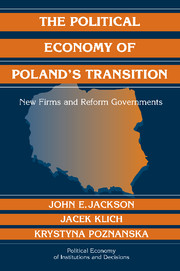Book contents
- Frontmatter
- Contents
- List of Tables
- List of Figures
- Acknowledgments
- List of Abbreviations
- 1 Why Poland?
- 2 The Dynamics of the Polish Political Economy, 1990–1997
- 3 Creative Destruction and Economic Transition
- 4 The Social and Distributional Costs of Transition
- 5 Individual Attitudes and Voting
- 6 De Novo Job Creation and Election Returns
- 7 Liberal Economic Interests and Seat Allocations
- 8 The Political Economy after 1997
- 9 The Political Economy of Transition: Why Poland?
- Appendix A Assessing Measures of New and Small Firms in Poland
- References
- Index
- Titles in the series
7 - Liberal Economic Interests and Seat Allocations
Published online by Cambridge University Press: 07 August 2009
- Frontmatter
- Contents
- List of Tables
- List of Figures
- Acknowledgments
- List of Abbreviations
- 1 Why Poland?
- 2 The Dynamics of the Polish Political Economy, 1990–1997
- 3 Creative Destruction and Economic Transition
- 4 The Social and Distributional Costs of Transition
- 5 Individual Attitudes and Voting
- 6 De Novo Job Creation and Election Returns
- 7 Liberal Economic Interests and Seat Allocations
- 8 The Political Economy after 1997
- 9 The Political Economy of Transition: Why Poland?
- Appendix A Assessing Measures of New and Small Firms in Poland
- References
- Index
- Titles in the series
Summary
The creation of a pro-reform constituency is a necessary but not a sufficient part of choosing a pro-reform government. The method for allocating seats in parliament once votes have been cast is a critical concern. In any system, but particularly in a parliamentary system with proportional representation, such as Poland's, the electoral rules creating voting and parliamentary districts and determining how votes are converted to seats for these districts have a critical bearing on what influence pro-reform interests can exert on national policy. At this point the findings about the clustering of new enterprises and the agglomeration effects identified in Chapter 3 become very important. The location effects lead to new businesses being concentrated in certain areas, even beyond what traditional factor prices and resources would predict. A consequence of this clustering is that the pro-reform voters will also be concentrated rather than being widely distributed across the country. Thus, how districts are drawn and how seats are apportioned will affect the representation of liberal interests.
SEAT ALLOCATION RULES
A critical set of rules was adopted prior to the 1993 election at the urging of the coalition led by the UD. The political instability experienced after the 1991 elections was attributed, with some justification, to the presence of so many small parties in the parliament. Three critical rules were designed to reduce the representation of smaller parties and to push consolidation of existing parties: parties had to attain 5 percent and coalitions 8 percent of the national vote in order to hold seats in the new Sejm; there was a national list of sixty-nine seats allocated to parties with more than 7 percent of the national vote; and the d'Hondt formula was used to allocate seats within each voivodship among the eligible parties.
- Type
- Chapter
- Information
- The Political Economy of Poland's TransitionNew Firms and Reform Governments, pp. 178 - 201Publisher: Cambridge University PressPrint publication year: 2005

